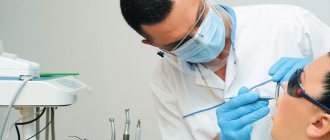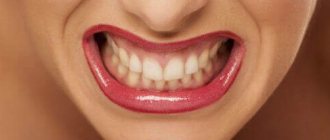“Mask or treat”: what to do if the tooth under the crown emits an unpleasant odor
Article navigation
- Why does the smell appear?
- - due to the patient's fault
- - due to the doctor's fault
- Where does the smell come from?
- Associated symptoms
- What you can do yourself
- Treatment in dentistry
- Complications
Question for a specialist
After prosthetics, a person, as a rule, begins to smile more, communicate more, and restricts himself less in diet.
But sometimes you can notice such an unpleasant manifestation as a smell from under the crown of a tooth. This is definitely not considered a normal option, so the problem needs to be fixed. Today we will tell you why there is a bad smell under crowns and how to get rid of it completely.
Selecting a crown system
| Type | Material | Purpose |
| Solid metal | The design is based on a cobalt-chromium alloy or gold | A popular type of prosthetics, but less and less used |
| Ceramic | Ceramics | Individual unit prosthetics and bridges |
| Metal-ceramic | Metal frame covered with ceramics | Dental crowns per unit, production of fixed bridges and removable dentures |
| Zirconium | The surface is covered with ceramics, and the base is zirconium dioxide. | dental crowns per unit, production of fixed bridges and removable dentures |
Why does the prosthesis smell bad?
Before you figure out what to do and how to eliminate the unpleasant odor from a tooth under a crown, you need to understand why it appears in the first place. Because it depends on the source how best to get rid of the repulsive “aroma”. The reasons for the unpleasant odor from under the crowns may depend both on the behavior of the patient after prosthetics, and on the not very competent actions of dentists (therapist, orthopedist, implantologist), and the low qualifications of the dental technician making the prosthesis1. Let's look at these reasons in more detail.
DENTAL PROSTHESIS ON 6 IMPLANTS - 290,000 rub.
The price includes all manipulations for installing Osstem implants (South Korea), manufacturing, installing and fitting the prosthesis, including anesthesia and diagnostics.
Save RUB 30,000. >> Call now or request a call
Opening hours: 24 hours a day - seven days a week
Patient-specific reasons
The reason why there is an unpleasant odor coming from under the crown may be the patient’s careless attitude towards his teeth – natural and artificial. Often these are the following errors in hygiene or nutrition:
- unsatisfactory or irregular oral hygiene: if you do not remove soft food plaque from the crowns, then it becomes a source of accumulation of microbes. They irritate the gums, leading to inflammation and suppuration. Also, plaque over time transforms into hard stone and “grows” under the gum along the root or implant, causing diseases - periodontitis, peri-implantitis,
- overloading of dentures: when chewing very hard products or objects, the denture may be damaged, the fixing cement may come off, the support (stump) may crack or the pin may break - as a result, bacteria or food particles will penetrate the stump or roots under the crown, which will cause a putrid odor.
Immediately after dentures, a smell from under the tooth crown, caused by the attitude of the person himself, is unlikely to appear. But after many months or even several years, this is the most likely reason. By the way, it is quite likely that the service life of the crown has simply come to an end, and the tooth underneath it has begun to rot due to the fact that its “life span” has also ended - after all, it was once subjected to grinding and removal of the nerve.
One of the reasons why a person feels that there is a strong odor coming from under the crown may be halitosis. Halitosis is a manifestation of any diseases of the internal organs or bad habits of the patient (smoking, love of sweets, fast food), which is expressed by an unpleasant “aroma” from the mouth. Another reason is an allergy to the materials from which the prosthesis is made.
Reasons depending on the doctor
The reasons why there is an odor coming from under the crown related to preparation for prosthetics or the prosthetics themselves are as follows:
- incomplete diagnosis: even before teeth restoration, professionals use X-ray examination to identify hidden pathologies (cysts under the roots, for example). But if the doctor neglected the preparation and did not detect the disease, then some time after the prosthetics the smell of rot under the crown may appear,
- overheating of dentin during grinding of the stump: as a result, caries, pulpitis can occur, and if they are not eliminated, inflammation or neoplasms under the roots,
- the roots were poorly prepared: for example, if violations were made during the removal of the dental nerve, filling the canals,
- the pin/stump is installed incorrectly,
- unclearly taken impressions (casts),
- unsuitable prosthesis: if the edge of the crown is too high, then there is an empty area between it and the gum - microbes penetrate there, causing inflammation of the gums and caries under the prosthesis. If the edge of the crown is very low, then it injures the gums - it scratches it and disrupts metabolic processes. The gums become inflamed or move away from the dentures with the formation of periodontal pockets, where food and bacterial plaque again become clogged,
- low-quality materials for prosthetics,
- incorrect choice of implant: when for a patient with periodontitis and severely inflamed gums a model is selected not with a smooth antibacterial surface, but with a rough one, microbes quickly “stick” to it, causing inflammation,
- the implant was installed with errors: for example, its tip “pierced” the bottom of the nasal sinus and caused sinusitis.
Unlike the previous point, the smell under the dental crown, which arose due to iatrogenic reasons (unintentionally provoked by the doctor), appears quite quickly after prosthetics - literally in a few days or weeks.
Read on the topic: what complications do patients encounter most often after prosthetics - how to detect and eliminate them in time.
What hygiene products are needed and can be used?
What hygiene products are needed and can be used?
| NAME | DESCRIPTION |
| Toothbrush | The bristles should be soft or medium hard. Too hard ones can damage the material and leave small scratches on it, in which plaque will accumulate. The use of an ultrasonic or mechanical brush is allowed, but it is very important to carefully select attachments - they should not have plastic elements (often used to better clean or whiten teeth). |
| Toothpaste | It is better to use prophylactic toothpaste WITHOUT abrasive substances - they can damage the materials. |
| Irrigator | It will allow you to remove food debris from the interdental spaces, especially if several crowns are installed in a row or dental bridges are present - in such a situation, a stream of water will remove food debris from under the structure. |
| Mouthwash | It should be selected in accordance with existing oral problems - for example, to combat gum inflammation, to strengthen enamel or to prevent plaque accumulation. That is, regardless of whether you have dentures or not. |
How to recognize the disease by accompanying symptoms
An unpleasant odor from under the crown of a tooth is often accompanied by various additional symptoms. A person may experience one or more of the following symptoms, which occur with varying frequency and strength. Moreover, accompanying symptoms may appear both before the “amber” begins to be felt from under the prosthesis, and after. What you need to pay close attention to, consider in the following list:
- the prosthesis has become mobile: the crown or bridge has begun to move, wobble,
- the prosthesis is broken: it may be a chipped piece or a large crack,
- pain appears: for example, when closing the jaws, while chewing, when eating hot / cold / sour food or drinks, while brushing your teeth, or it may hurt “just because”, i.e. without obvious irritant,
- the gums around the prosthesis changed color: it turned red, turned white, became “cyanotic”,
- the appearance of pus from under the gums, a fistula may form,
- enlargement of the submandibular lymph nodes,
- runny nose, loss of smell (due to sinusitis or sinusitis caused by a bad tooth or implant),
- increased body temperature, headache, weakness,
- numbness of the jaw, tongue,
- sour, sweet or “strange” taste in the mouth,
- galvanic syndrome: the occurrence of an electrical impulse between prostheses with inclusions of dissimilar metals.
“A couple of weeks ago I began to notice that the crown that was placed on a broken tooth 4-5 years ago began to move a little. It seems to be a little at all, and it seemed to me that it was uncritical. But just a few days later, a strange smell appeared from it, then the gums turned red, and the pus was squeezed out. And a week later it just broke off and fell out.”
Ksenia Andreevna, review from gidpozubam.ru
Can I use dental floss?
If you have any dentures in your mouth, you should either refuse floss completely or use it too carefully. The crowns are fixed in such a way that natural micro-gaps between them are preserved, which require cleansing. However, when flossing, you should not make vertical movements - only horizontal ones. That is, you need to insert the thread not from the cutting edge, gradually moving towards the gums, but place its tip directly into the gap - make several horizontal movements and remove it in a similar way.
Do not use the prosthesis if it has a chip or crack - try to see a doctor as soon as possible to restore the integrity of the crown/inlay or for a prompt replacement. Otherwise, there is a high risk of developing inflammatory processes under the prosthesis.
What you can do yourself
How to remove the smell under the crown yourself? Home help in solving the problem consists of strengthening hygiene - brushing your teeth 2-3 times a day with a brush and toothpaste, using rinses, dental floss labeled “super-floss”, and using an irrigator. But these measures can only help if the smell has appeared recently and the patient knows that this was due to irregular oral hygiene in the last week or two. Although only people with a very sensitive sense of smell are able to detect “amber” at an early stage.
In other cases, if the plaque or tartar is already old or the bad odor appears due to a disease or poor-quality prosthetics, then any home methods will be ineffective. The “aroma” will simply be masked if, for example, you chew mint gum or anise or fennel seeds, but the problem will remain and in a short time will definitely make itself felt with renewed vigor.
How much can you eat after dentures?
After installing permanent crowns or inlays, you can drink water immediately, but eat after 1.5-2 hours. This is not related to the type of prosthesis or the adhesive used for fixation. During treatment, anesthesia is used - and it is very important that its effect wears off completely, otherwise chewing can injure the tongue or the inside of the cheeks.
After installing temporary crowns or inlays, you are allowed to eat food after 2-3 hours. However, in such a situation, it is strongly recommended not to put any stress on the restored tooth and try to chew food on the other side - not only at first, but throughout the entire period of wearing the temporary structure. It is impossible to put a load on such prostheses - they are not designed for it (naturally, if we are talking about crowns or inlays, which are installed for a maximum of 2-3 weeks, and not for a long time).
How is treatment carried out in dentistry?
How to remove unpleasant odor under the crown of a tooth forever? To do this, you should contact your dentist. But what the doctor will do, how he will eliminate the problem, depends on its cause. Let's consider ways of professional help below:
- treatment or filling of the stump, roots: can be carried out both with removal of the crown and without removal - in this case, a small hole is drilled in the upper part of the prosthesis and the doctor works through it. The integrity of the structure will then be restored using a composite filling,
- treatment of gums with anti-inflammatory, antibacterial drugs, as well as means for regeneration: these can be applications or injections in dentistry, then the patient is prescribed rinses at home (more on this below),
- making a new prosthesis: if the old one is broken and cannot be restored, or if it is of an unsuitable shape or consists of allergenic materials,
- cystectomy or cystotomy: removal of the cyst through a lateral incision in the gum and jaw bone,
- resection of the root apex or hemisection of the tooth: when the diseased root can be removed simultaneously with the cyst - partially or entirely,
- treatment of mucositis or peri-implantitis (inflammation of the gums and jaw bone around the implant),
- removal of the implant, after which, according to indications, the perforation of the maxillary fundus is closed, the bone volume is restored by replanting bone chips.
You need to understand that treatment is not a quick process. It can take from several days or weeks to several months (full recovery).
Often, in addition to the main treatment, antibiotics and antihistamines, vitamin and mineral complexes, gels for gum regeneration, as well as oral baths or rinses are prescribed. How to rinse your mouth if there is an odor coming from under the crown? The dentist can prescribe solutions of Chlorhexidine, Miramistin, Furacilin, infusion of chamomile, sage, and oak bark for these purposes. The rinse is selected by the doctor individually based on the clinical picture.
BEST REMOVABLE DENTURE - 20,000 rub.
All manipulations for the manufacture, installation and fitting of the prosthesis, including impressions, are included.
Save RUB 10,000! >> Call now or request a call
Opening hours: 24 hours a day - seven days a week
Consequences. What are the consequences of not removing food between teeth on time?
Stuck food between the teeth is a source of constant irritation of the gums, which ultimately causes inflammation:
- The occurrence of bleeding, gingivitis or periodontitis
- There is an unpleasant odor from the mouth, the necks of the roots of the teeth may be exposed
- In extreme cases, tooth loosening and loss due to bone destruction.
The food itself is a breeding ground for microorganisms in the oral cavity, therefore increasing the risk of developing caries between teeth. Caries on contact surfaces is rarely detected in the initial stages (hidden caries) and in the future can lead to inflammation of the pulp with severe pain.
Complications when refusing treatment
Many people, in the absence of pain, first try home methods for eliminating unpleasant odors. As a result, most of them still go to the doctor. But it happens that it is too late, and conservative treatment is not enough, because... complications began. Therefore, it is better to go to the dentist if any alarming symptoms appear, otherwise you may lose a tooth and even neighboring ones. Severe inflammation may begin - abscess, phlegmon, osteomyelitis, which take a long and painful time to treat.
1Massironi D. Accuracy and aesthetics. Clinical and dental stages of dental prosthetics, 2008.
Your questions and answers
QUESTION If I have a rotten smell from under the crown, what is the best way to remove it? I tried rinsing with oak bark, but it didn’t do much good... Nikolay F.
ANSWER Hello, Nikolay. The best option is to consult a dentist. A putrid smell is a clear symptom of some pathological process that is not noticeable to you if there are no other visible signs. Simply put, the tooth or gum rots from the inside. The consequences of not seeking qualified help in a timely manner can be very serious - inflammation of the jaw, spread of infection throughout the body through the bloodstream, etc. Therefore, please do not delay your visit to the doctor. Rinsing alone will not cope with your situation.
Author: Dulgarov Zh. G. (Thank you for your help in writing the article and the information provided)
Diagnostics
The dentist can determine the degree of destruction of a tooth covered with a crown using certain diagnostic methods.
Visual examination of a diseased tooth
The specialist conducts a thorough external examination to determine whether there is a problem. Particular attention is paid to the following points:
- is there swelling?
- is loose or not;
- is there any redness on the gums;
- how the color of the tooth enamel under the crown has changed.
Important: a visual examination allows the dentist to make only a preliminary diagnosis, which can only be confirmed by the results of hardware treatment.
X-ray
X-ray examination helps to accurately determine the condition of a tooth covered with a crown. From the image, the doctor is able to determine not only the affected area, but also the depth of the infection. X-rays also help to assess the quality of previous treatment and the accuracy of the fit of the prosthetic material to the stump.
CT scan
Indicated in cases where other diagnostic methods do not provide a complete, objective picture of the pathological process.
Causes of tooth decay
So, your tooth has started to rot. The first thing that appears in your head along with horror is the question: “Why? The main reasons for the destruction of dentition units include:
- Nicotine, strong alcoholic drinks, drugs.
- Fluoride-poor city water and poor environmental conditions.
- Insufficient oral care. Perhaps, in addition to regularly brushing your teeth, you should get into the habit of rinsing your mouth after every meal and using dental floss.
- Hereditary predisposition.
- Abuse of flour, sweet and sour foods.
- Deficiency of vitamins and minerals.
- Diseases of internal organs of a chronic nature.
- Inflammatory processes and mucous membranes.
Pus that accumulates in the soft periodontal tissues and under the roots contains multi-million colonies of pathogenic bacteria, which spread through the blood vessels throughout the body, poisoning it. That is why many dentists are inclined to the theory that tooth decay provokes the development of various pathological conditions of internal organs, including the heart.
Preventive measures
- Pay attention to hygiene. In addition to the brush, use thread and tools. Get rid of food residues in interdental spaces and other secluded places. Do not get carried away with bleaching pastes and powders with harsh abrasives.
- Think about your diet. Bone resorption is accelerated by calcium and silicon deficiency. When dieting, you need to compensate for the lack of elements with a vitamin-mineral complex.
- Control the consumption of sweets, soda, and other foods with sugar. Dressings with vinegar, sour juices, and fruits have an aggressive effect.
- Avoid harsh mechanical impact on the jaw apparatus. The appearance of chips and cracks leads to erosion when dentin is destroyed.
- Visit the dentist every six months for preventive care.
Among the effective methods for preventing rotting are:
- professional cleaning;
- remineralization.
The procedures are available and have no age restrictions. The treatment will eliminate plaque and tartar deposits that lead to caries. Remineralization is aimed at replenishing the deficiency of calcium and fluoride, which are applied locally. The drugs prevent erosion.
An effective measure is fissure sealing. Sealing the grooves prevents the accumulation of food residues, which lead to the growth of dangerous bacteria.










